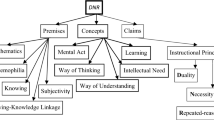Abstract
In two dimensions (2D), representations associated with slopes are seen in numerous forms before representations associated with derivatives are presented. These include the slope between two points and the constant slope of a linear function of a single variable. In almost all multivariable calculus textbooks, however, the first discussion of slopes in three dimensions (3D) is seen with the introduction of partial derivatives. The nature of the discussions indicates that authors seem to assume that students are able to naturally extend the concept of a 2D slope to 3D and correspondingly it is not necessary to explicitly present slopes in 3D. This article presents results comparing students that do not explicitly discuss slopes in 3D with students that explicitly discuss slopes in 3D as a precursor to discussing derivatives in 3D. The results indicate that students may, in fact, have significant difficulty extending the concept of a 2D slope to a 3D slope. And that the explicit presentation of slopes in 3D as a precursor to the presentation of derivatives in 3D may significantly improve student comprehension of topics of differentiation in multivariable calculus.
Similar content being viewed by others
References
Arnon, I., Cotrill, J., Dubinsky, E., Octaç, A., Roa Fuentes, S., Trigueros, M. & Weller, K. (2013). APOS theory: A framework for research and curriculum development in mathematics education. New York: Springer.
Asiala, M., Brown, A., DeVries, D., Dubinsky, E., Mathews, D. & Thomas, K. (1996). A framework for research and curriculum development in undergraduate mathematics education. Research in Collegiate Mathematics Education, 2(3), 1–32.
Dubinsky, E. (1991). Reflective abstraction in advanced mathematical thinking. In D. Tall (Ed.), Advanced mathematical thinking (pp. 95–126). Dordrecht: Kluwer.
Duval, R. (1999). Representation, vision and visualization: Cognitive functions in mathematical thinking. Basic issues for learning. In F. Hitt & M. Santos (Eds.), Proceedings of the Twenty-first Annual Meeting of the North American Chapter of the International Group for the Psychology of Mathematics Education (PME), (Vol. 1, pp. 3-26), Mexico: PME.
Duval, R. (2006). A cognitive analysis of problems of comprehension in a learning of mathematics. Educational Studies in Mathematics, 61, 103–131.
Edwards, H., and Penney, D. (2008). Calculus: Early Transcendentals 6th Edition, Prentice Hall.
Erikson Institute, The Early Mathematics Collaborative (2013), Big Ideas of Early Mathematics: What Teachers of Young Children Need to Know, Pearson Education US, ISBN: 9780132946971.
Glaser, B. G. (1998). Doing grounded theory: Issues and discussions. Mill Valley: Sociology.
Heid, K. M. (1988). Resequencing skills and concepts in applied calculus using the computer as a tool. Journal for Research in Mathematics Education, 19(1), 3–25.
Huang, C. H. (2011). Engineering students’ conceptual understanding of the derivative in calculus. World Transactions on Engineering and Technology Education, 9, 209–214.
Kant, I. (1929). Critique of Pure Reason. (N. K. Smith, Trans.). London: Macmillan. (Original work published 1781).
McGee, D. & Martinez-Planell, R. (2013). A study of effective application of semiotic registers in the development of the definite integral of functions of two and three variables. International Journal of Science and Mathematics Education. doi:10.1007%2Fs10763-013-9437-5.
McGee, D., Moore-Russo, D., Ebersole, D., Lomen, D. & Marin, M. (2012). Visualizing three-dimensional calculus concepts: The study of a manipulative’s effectiveness. Primus, 22(4), 265–283.
Moore-Russo, D. & Viglietti, J. M. (2012). Using the K5 connected cognition diagram to analyze teachers’ communication and understanding of regions in three-dimensional space. Journal of Mathematical Behavior, 31, 235–251.
Moore-Russo, D., Conner, A. & Rugg, K. I. (2011). Can slope be negative in 3-space? Studying concept image of slope through collective definition construction. Educational Studies in Mathematics, 76(1), 3–21.
Nagle, C. & Moore-Russo, D. (2014). The concept of slope: Comparing teachers’ concept images and instructional content. Investigations in Mathematics Learning, 6(2), 1–18.
Nagle, C., Moore-Russo, D., Viglietti, J. M. & Martin, K. (2013). Calculus students’ and instructors’ conceptualizations of slope: A comparison across academic levels. International Journal of Science and Mathematics Education, 11(6), 1491–1515.
Parzysz, B. (1988). Knowing versus seeing: Problems of the plane representation of space geometry figures. Educational Studies in Mathematics, 19(1), 79–92.
Piaget, J. (1971). Biology and knowledge. Chicago: University of Chicago Press. Original work published 1967; (B. Walsh, Trans.).
Piaget, J. (1977). Understanding causality. New York: Norton (D. Miles and M. Miles, Trans.).
Rodriguez, P. (2008). Calculus for the biological sciences. New York: Wiley.
Roorda, G., Vos, P. & Goedhart, M. (2009). Derivatives and applications; development of one student’s understanding. Proceedings of CERME 6, January 28th-February 1st 2009, Lyon France. Working group 12. Available at http://www.inrp.fr/editions/cerme6. Accessed 1 May 2014.
Stewart, J. (2006). Calculus: early transcendentals (6th ed.). Boston: Thomson-Brooks/Cole.
Strauss, M., Bradley, G. & Smith, K. (2002). Calculus (3rd ed.). Upper Saddle River: Prentice Hall.
Swokowski, E., Olinick, M. & Pence, D. (1992). Calculus (6th ed.). Boston: PWS.
Tall, D. (2010). A sensible approach to the calculus. Plenary Session at The National and International Meeting on the Teaching of Calculus, 23–25th September 2010, Puebla, Mexico. Available at http://homepages.warwick.ac.uk/staff/David.Tall/downloads.html. Accessed 1 May 2014.
Waner, S. & Costenoble, S. (2007). Finite mathematics and applied calculus (4th ed.). Boston: Thomson-Brooks/Cole.
Zandieh MJ (2000). A theoretical framework for analyzing student understanding of the concept of derivative. CBMS Issues in Mathematics Education, 8, 103–122.
Author information
Authors and Affiliations
Corresponding author
Electronic Supplementary Material
Below is the link to the electronic supplementary material.
ESM 1
(DOC 772 kb)
Rights and permissions
About this article
Cite this article
McGee, D.L., Moore-Russo, D. IMPACT OF EXPLICIT PRESENTATION OF SLOPES IN THREE DIMENSIONS ON STUDENTS’ UNDERSTANDING OF DERIVATIVES IN MULTIVARIABLE CALCULUS. Int J of Sci and Math Educ 13 (Suppl 2), 357–384 (2015). https://doi.org/10.1007/s10763-014-9542-0
Received:
Accepted:
Published:
Issue Date:
DOI: https://doi.org/10.1007/s10763-014-9542-0




